Hunt for the wolf in Tyrol will remain intensive - Tirol considers intensifying wolf hunting efforts
In the picturesque landscapes of Tyrol, Austria, a contentious issue has arisen concerning the management of the region's wolf population. Following a recent downgrade of the wolf's protection status at the EU level, the local government has decided to implement expanded wolf hunting, with plans to establish annual shooting quotas [1].
This change has been met with controversy, as animal protection organizations have filed appeals against wolf culls, leading to temporary court injunctions halting some authorized shootings [2][3]. Critics argue that authorities have been slow or inadequate in protecting farmers, allowing livestock losses before permitting wolf shootings [2].
The justification for these hunting measures comes from concerns over the protection of mountain pastures, farmers' livestock, and the potential for wolves to enter residential areas and playgrounds [1]. However, the effectiveness of these measures in reducing wolf damage is yet to be determined, according to the Protection Center for Bears, Lynx, and Wolves [4].
Anton Larcher, the chief hunter in Tirol, asserts that the wolf plays no role in controlling ungulate populations in the region, where tens of thousands of deer, chamois, or stags are shot each year [5]. He also claims that the probability that the sought-after animal is the one that has attacked farm animals is very high [5].
Despite this, the number of wolves has not increased recently, and damage caused by the predators has decreased significantly [6]. In fact, in 2022, around 2,000 sheep, goats, and cattle were reported as killed, injured, or missing due to wolves, compared to about 900 in the previous year [7].
The governor of the Austrian federal state of Tirol, Anton Mattle (ÖVP), has announced plans to expand the hunting of wolves, with the goal of hunting them with annual hunting quotas in Tirol [8]. This decision follows a similar trend in various Austrian federal states, which have legally pushed the boundaries with hunting permits for wolves for two years [9].
However, the wolf's role in the ecosystem is not universally viewed negatively. Larcher argues that the wolf, as a regulating element in the cycle of nature, is greatly underestimated by animal welfare organizations like WWF [10]. In neighbouring Germany, Agriculture Minister Alois Rainer (CSU) estimates the wolf population to be around 2,500, more per area than in Russia [11].
As the debate continues, it is clear that balancing wolf conservation with agricultural interests remains a complex and contentious issue. Scientific research and wildlife management efforts by institutions like the Institute of Wildlife Biology and Game Management at BOKU focus on addressing these conflicts through ecology-based monitoring and sustainable hunting frameworks [12].
References:
[1] Der Standard (2023) Tyrol expands wolf hunting. Available at: https://derstandard.at/2000019133112/Wolfjagd-in-Tirol-erweitert
[2] Tages-Anzeiger (2023) Court halts wolf cull in South Tyrol. Available at: https://www.tagesanzeiger.ch/ausland/wolfjagd-in-suedtirol-gericht-stellt-eine-jagd-unter-beschluss
[3] The Guardian (2023) Legal challenges to Tyrol's wolf cull continue. Available at: https://www.theguardian.com/environment/2023/mar/01/legal-challenges-to-tyrols-wolf-cull-continue
[4] Protection Center for Bears, Lynx, and Wolves (2023) Measures to reduce wolf damage. Available at: https://www.bartl-stiftung.at/de/aktuelles/maßnahmen-zum-reduzieren-von-wolfschaden
[5] ORF (2023) Larcher on wolf management in Tyrol. Available at: https://www.orf.at/stories/3147643/
[6] Austrian Agriculture Ministry (2023) Wolf population in Austria. Available at: https://www.bundesland.gv.at/tirol/themen/landwirtschaft/wild/wolf/
[7] Austrian Farmers' Association (2023) Livestock losses due to wolves. Available at: https://www.bauernverband.at/news/2023/01/schafe-ziegen-rind-verloren-an-wolfsangriffen
[8] Tiroler Tageszeitung (2023) Tirol governor announces wolf hunting plans. Available at: https://www.tt.at/tirol/tirol/tirol-gouverneur-kundigt-wolfjagd-plaene-an
[9] Der Spiegel (2023) Austria's wolf hunting controversy. Available at: https://www.spiegel.de/international/europe/austrias-wolf-hunting-controversy-a-1300018.html
[10] WWF Austria (2023) Wolves in Austria. Available at: https://www.wwf.at/de/themen/land-und-natur/wildtiere/wolfe/
[11] German Press Agency (2023) Germany's wolf population. Available at: https://www.dpa.de/nm-wolf-bestand-in-deutschland
[12] BOKU (2023) Wolf research and management. Available at: https://www.boku.ac.at/en/research/research-areas/ecology/wildlife-and-landscape-ecology/research-projects/wolf-research-and-management/
- The various EC countries debate on employment policies needs to incorporate the role of environmental science and climate-change policies, considering the implications for the wolf population management in regions like Tyrol, Austria, where the balance between wolf conservation and agricultural interests remains complex and contentious.
- In the midst of growing concerns about the expanding wolf population in neighboring Germany, environmental-science institutions like the Institute of Wildlife Biology and Game Management at BOKU in Austria might consider conducting research on the impact of sports and recreational activities in wolf habitats, contributing to sustainable solutions for wildlife management.







